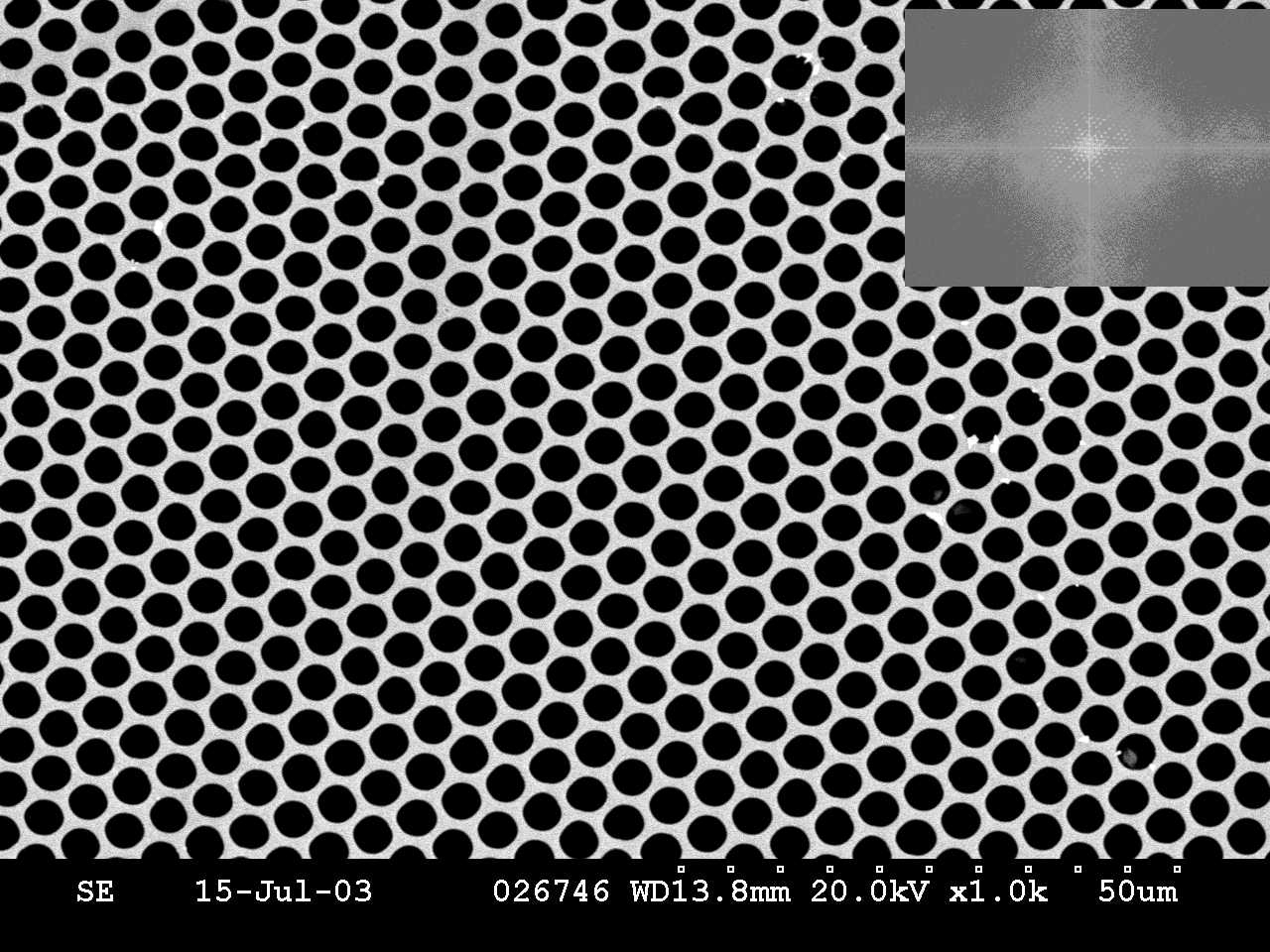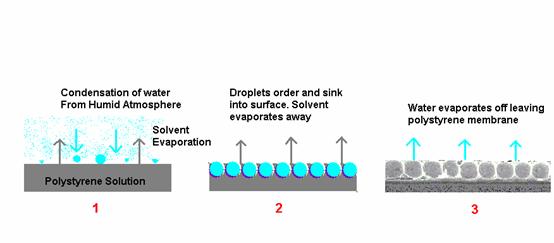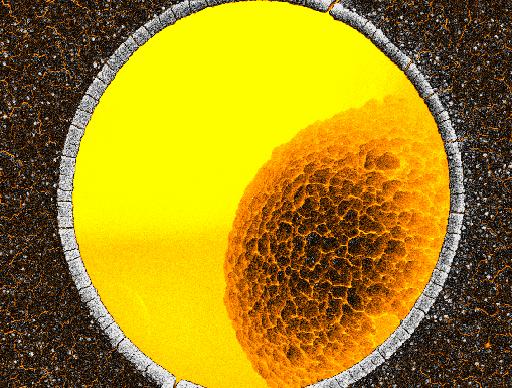Nanoscale Characterisation & Processing |
|
Main Navigation
|
Nanoscale Photonics and Plamonics Patterns have always proven fascinating both for their mathematical and their aesthetic qualities. Ordered structures have a way of cropping up in nature, for example the iridescence of a butterfly wing, the spiral structure of a shell or the packing of cells in honeycomb, just to name a few. It is not surprising that historically they should have proven fascinating to philosophers, mathematicians and artists. Now it is the turn of the materials scientist. In 1994 Widawski et al [1] discovered the self-organization of water droplets in a solution of polystyrene-polyparaphenylene block copolymers in carbon disulfide. Subsequent work by Srinivasarao et al in 2001 led to the development of different structures by tuning the properties of the solution using various solvents [2]. We have built on this work by employing a greater number of solvents and by characterizing the resulting membranes using optical microscopy, atomic force microscopy and scanning electron microscopy.
Figure 1. Hexagonally close packed pores from a solution of dicarboxy terminated polystyrene in Carbon Disulfide. The formation of the hexagonally close packed (hcp) structure is suspected to be due to the formation of breath figures and aided by Rayleigh-Bénard convection. Firstly the polymer solution is drop cast on to a clean glass substrate. The sample is then placed in a chamber which is humidity controlled. The rapidly evaporating solvent causes the sample to have a low surface temperature, bringing the surface below dew point so that the water vapour begins to condensate. These water droplets then aggregate to form breath figures on the surface of the solution. The solvent eventually evaporates completely leaving behind the ordered polymer substrate. Subsequent evaporation of the water droplets leaves behind the structure we observe. Figure 2. Mechanism for formation of ordered membranes.
As well as being aesthetically pleasing these porous membranes also have possible commercial physical applications. In 1987 Yablonivich et al [3] demonstrated that periodic structures could be used as photonic band gap materials. These materials form an optical periodic array which manipulates light travelling through it in the same manner that semiconductor materials manipulate electrons travelling through them. This has led to many advances in photonics as the trophy of replacing electrons with photons in computing edges ever closer. Using photons would allow faster computing (since photons travel faster than electrons) with less heat dissipation.
But computing is not the only goal of photonics. More needs to be learned about the interactions between light and matter such as; how light is confined within resonant cavities? And how can light be directed by the manipulation of the boundaries which confine it?
One type of optical microcavity used is a small dielectric sphere. The behaviour of light within these spheres can be explained using the long established Mie theory of light scattering. This tells us that the optical modes supported within these spheres play a similar role to atomic orbitals in electronic systems. Following this analogy with quantum mechanics, these so called “whispering gallery modes” (WGM’s) are characterized by three integers n, l, and m corresponding to the radial, total angular momentum and the azimuthal quantum numbers, respectively. This approach has enabled small dielectric spheres one to be considered as “photonic atoms” in a tight-binding scheme. It is known that the resonant internal field of a spherical cavity is not completely confined to the interior of the microparticle. Depending on the size of the microsphere, the evanescent field can extend a couple of micrometers into the surroundings. On the other hand this partial delocalization of Mie resonance states is of great importance because this suggests a possibility for coherent coupling between WGM’s of two adjacent spherical particles with closely matched sizes. Such a system of coherently coupled “photonic atoms” may be called a “photonic molecule” and can be employed in order to manipulate photons on the micrometer length scale [4]. Our project involves controllably forming photonic molecules by template confinement and manipulation techniques and to study the electro-optical properties of these photonic molecule assemblies. The former technique involves placing spheres coated with luminescent quantum dots in a precisely designed polymer template with pores of sufficient depth to accommodate just two spheres. By controlling the pore diameter we can control the axis of excitation, analogous to tennis balls in a tube. The properties of the system are then studied by excitation of the photonic molecule, over whose geometry we have complete control. The optical properties are studied in conjunction with the Semiconductor Photonics group in the Department of Physics, Trinity College
Figure 3. Melamine Formaldehyde microsphere nestling in a pore. References [1]G. Widawski, M. Rawiso, and B. Francois. Nature 369, 1994. [2]M. Srinivasarao, D. Collings, A. Philips, and S. Patel. Science 292(79), 2001. [3]E. Yablonovitch, Phys. Rev. Lett. 58, 2059, 1987. [4] Y.P. Rakovich, J.F. Donegan, M. Gerlach, A.L. Bradley, T.M. Connolly, J.J. Boland, N. Gaponik, and A. Rogach, Physical Review A 70, 051801 (2004). |



